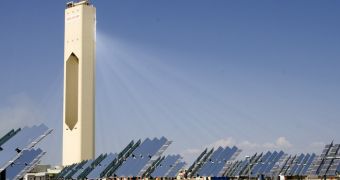Nowadays, the renewable sector benefits from amazing findings developed by experts using the most advanced technology. Some of the breakthroughs are actually unbelievably simple and inspired by nature.
One of the recent discoveries is that the romance of sunflowers with the sun could be analyzed and exploited to implement a new generation of concentrated solar power plants, much more efficient than the current ones.
Concentrated solar power (CSP) systems depend on mirrors or lenses to reflect a large area of sunlight, or solar thermal energy, onto a small area.
Eco-friendly power is generated after the concentrated light is transformed into heat. Heat is then used to drive an engine, connected to an electrical power generator.
In this case, Alexander Mitsos, a mechanical engineer from the Massachusetts Institute of Technology started taking into consideration the perfect geometry of the flower and tried to apply some changes to the current layouts, which reduce the energy-efficiency of the entire system.
After relying on computer simulations, Mitsos has reached the conclusion that putting mirrors closer together and creating an angle of 137 degrees, imitating a field of sunflowers, could actually increase the performance of the array.
Moreover, this ingenious solution is expected to lower the footprint of concentrated solar power (CSP) facilities by one fifth, according to the developer.
The array displayed by Gemsolar, located in Spain, designed to supply 25,000 households with clean power, starting 2013, occupies approximately 185 acres.
In fact, all major power plants built to provide alternative, eco-friendly power currently occupy a lot of space. Most of the arrays counting hundreds of giant mirrors, necessary for each and every facility, occupy an area as big as a football field.
While using computer simulations applied to a power plant from Spain, PS10, researchers have noticed that new smart layouts could require up to 20% less land than the ones built so far.
Mitsos thinks his breakthrough has a lot of potential and can be further exploited to make concentrating solar power facilities even more efficient.
If this design were to be implemented, it would help the solar industry preserve considerable surfaces of land while saving money.

 14 DAY TRIAL //
14 DAY TRIAL //